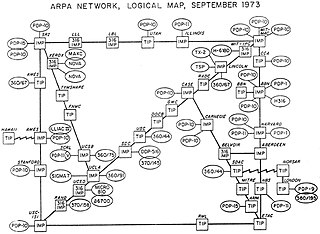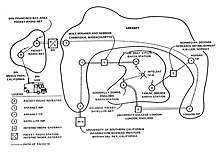Internetworking is the practice of interconnecting multiple computer networks, such that any pair of hosts in the connected networks can exchange messages irrespective of their hardware-level networking technology. The resulting system of interconnected networks are called an internetwork, or simply an internet.
The Internet Protocol (IP) is the network layer communications protocol in the Internet protocol suite for relaying datagrams across network boundaries. Its routing function enables internetworking, and essentially establishes the Internet.
The Internet protocol suite, commonly known as TCP/IP, is a framework for organizing the set of communication protocols used in the Internet and similar computer networks according to functional criteria. The foundational protocols in the suite are the Transmission Control Protocol (TCP), the User Datagram Protocol (UDP), and the Internet Protocol (IP). In the development of this networking model, early versions of it were known as the Department of Defense (DoD) model because the research and development were funded by the United States Department of Defense through DARPA.

In telecommunications, packet switching is a method of grouping data into packets that are transmitted over a digital network. Packets are made of a header and a payload. Data in the header is used by networking hardware to direct the packet to its destination, where the payload is extracted and used by an operating system, application software, or higher layer protocols. Packet switching is the primary basis for data communications in computer networks worldwide.
The end-to-end principle is a design framework in computer networking. In networks designed according to this principle, guaranteeing certain application-specific features, such as reliability and security, requires that they reside in the communicating end nodes of the network. Intermediary nodes, such as gateways and routers, that exist to establish the network, may implement these to improve efficiency but cannot guarantee end-to-end correctness.

Raytheon BBN is an American research and development company, based next to Fresh Pond in Cambridge, Massachusetts, United States.

The Advanced Research Projects Agency Network (ARPANET) was the first wide-area packet-switched network with distributed control and one of the first networks to implement the TCP/IP protocol suite. Both technologies became the technical foundation of the Internet. The ARPANET was established by the Advanced Research Projects Agency (ARPA) of the United States Department of Defense.

Robert Elliot Kahn is an American electrical engineer who, along with Vint Cerf, first proposed the Transmission Control Protocol (TCP) and the Internet Protocol (IP), the fundamental communication protocols at the heart of the Internet.

The Interface Message Processor (IMP) was the packet switching node used to interconnect participant networks to the ARPANET from the late 1960s to 1989. It was the first generation of gateways, which are known today as routers. An IMP was a ruggedized Honeywell DDP-516 minicomputer with special-purpose interfaces and software. In later years the IMPs were made from the non-ruggedized Honeywell 316 which could handle two-thirds of the communication traffic at approximately one-half the cost. An IMP requires the connection to a host computer via a special bit-serial interface, defined in BBN Report 1822. The IMP software and the ARPA network communications protocol running on the IMPs was discussed in RFC 1, the first of a series of standardization documents published by what later became the Internet Engineering Task Force (IETF).

Lawrence Gilman Roberts was an American engineer who received the Draper Prize in 2001 "for the development of the Internet", and the Principe de Asturias Award in 2002.
Peter Thomas Kirstein was a British computer scientist who played a role in the creation of the Internet. He put the first computer on the ARPANET outside of the US and was instrumental in defining and implementing TCP/IP alongside Vint Cerf and Bob Kahn.
Virgil Donald Cone was a technician and later researcher at SRI International who developed and ran the Packet Radio Van that was used in the first ARPANET internetworked transmission.

The Packet Radio Van was a van refitted by Don Cone at SRI International, and equipped with technology that was used in the first two-way internetworked transmission on August 27, 1976, and the first three-way internetworked transmission on November 22, 1977; the latter of which is considered the start of the Internet.

The NPL network, or NPL Data Communications Network, was a local area computer network operated by a team from the National Physical Laboratory in London that pioneered the concept of packet switching.

SATNET, also known as the Atlantic Packet Satellite Network, was an early satellite network that formed an initial segment of the Internet. It was implemented by BBN Technologies under the direction of the Advanced Research Projects Agency.

The ARPANET pioneered the creation of novel encryption devices for packet networks in the 1970s and 1980s, and as such were ancestors to today's IPsec architecture, and High Assurance Internet Protocol Encryptor (HAIPE) devices more specifically.
Roger Anthony Scantlebury is a British computer scientist who worked at the National Physical Laboratory (NPL) and later at Logica.
The International Networking Working Group (INWG) was a group of prominent computer science researchers in the 1970s who studied and developed standards and protocols for computer networking. Set up in 1972 as an informal group to consider the technical issues involved in connecting different networks, it became a subcommittee of the International Federation for Information Processing later that year. Ideas developed by members of the group contributed to the original "Protocol for Packet Network Intercommunication" proposed by Bob Kahn and Vint Cerf in 1974.
A long-running debate in computer science known as the Protocol Wars occurred from the 1970s to the 1990s when engineers, organizations and nations became polarized over the issue of which communication protocol would result in the best and most robust computer networks. This culminated in the Internet–OSI Standards War in the late 1980s and early 1990s, which was ultimately "won" by the Internet protocol suite ("TCP/IP") by the mid-1990s and has since resulted in most other protocols disappearing.











